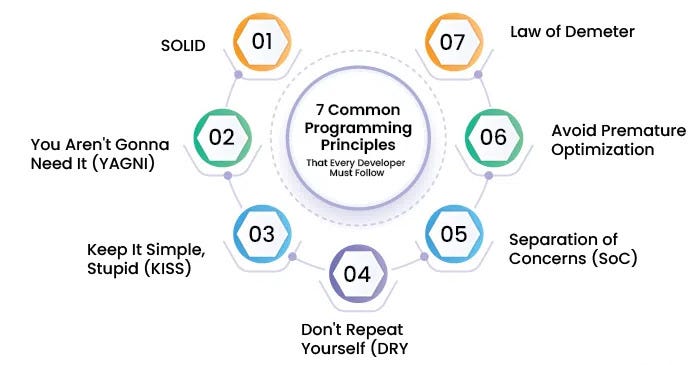🚀 Coding at the Best: Master the Fundamentals & Level Up Your Skills! 💻✨
🚀 Coding at the Best: Master the Fundamentals & Level Up Your Skills! 💻✨
Coding isn’t just about writing lines of text — it’s an art 🎨, a science 🔬, and a superpower 💥. Whether you’re a newbie or a seasoned developer, following fundamental rules and principles ensures your code is clean, efficient, and scalable. Let’s dive into the must-know principles with practical examples!

🧠 Core Coding Principles to Live By
1. KISS: Keep It Simple, Stupid! 🤫
The simpler your code, the easier it is to debug, maintain, and scale. Avoid overcomplicating solutions.
Bad Example ❌:
def calculate_average(numbers):
total = 0
length = 0
for num in numbers:
total += num
length += 1
return total / lengthGood Example ✅:
def calculate_average(numbers):
return sum(numbers) / len(numbers)2. DRY: Don’t Repeat Yourself 🔄
Repeating code? Stop! Reuse logic via functions, loops, or classes.
Bad Example ❌:
console.log("Hello, Alice!");
console.log("Hello, Bob!");
console.log("Hello, Charlie!");Good Example ✅:
const names = ["Alice", "Bob", "Charlie"];
names.forEach(name => console.log(`Hello, ${name}!`));3. SOLID Principles 🏗️
A set of object-oriented design principles for robust architecture:
- Single Responsibility: A class should have one job.
- Open/Closed: Open for extension, closed for modification.
- Liskov Substitution: Subclasses should replace parent classes.
- Interface Segregation: Avoid bulky interfaces.
- Dependency Inversion: Depend on abstractions, not concretions.
Example 🌟:
// Single Responsibility: A class to handle user authentication only
class AuthService {
public boolean login(String username, String password) { ... }
public void logout(User user) { ... }
}🛠️ Best Practices for Clean Code
4. Meaningful Names 🏷️
Variables/functions should self-document. Avoid x, temp, or data.
Bad Example ❌:
def fn(a, b):
return a * bGood Example ✅:
def calculate_area(length, width):
return length * width5. Comment Wisely 🗒️
Comments should explain why, not what.
Bad Example ❌:
let x = 5; // Assign 5 to xGood Example ✅:
const MAX_RETRIES = 5; // Limits API retries to avoid server overload6. Test, Test, Test! 🧪
Write unit tests to catch bugs early.
Example in Python 🐍:
def test_calculate_average():
assert calculate_average([2, 4, 6]) == 4
assert calculate_average([]) == 0 # Handle edge cases!⚠️ Common Pitfalls to Avoid
7. Ignoring Edge Cases 🚧
What if the input is empty? Negative? Huge?
Bad Example ❌:
def divide(a, b):
return a / b # Fails if b = 0!Good Example ✅:
def divide(a, b):
if b == 0:
raise ValueError("Cannot divide by zero!")
return a / b8. Over-Engineering 🚀➡️🌍
Don’t build a spaceship when a bicycle works.
Bad Example ❌:
Creating a microservice for a to-do list app with 10 users.
Good Example ✅:
Start with a monolithic architecture and scale as needed.
🎯 Final Pro Tips
- Refactor Ruthlessly 🔄: Improve code structure without changing functionality.
- Version Control 📚: Use Git religiously.
git commit -m "Save progress!" - Learn from Others 👥: Read open-source code (GitHub is your friend!).
🌟 Wrap-Up: Code Like a Pro!
Mastering these fundamentals isn’t just about writing code — it’s about crafting maintainable, efficient, and elegant solutions. Keep practicing, stay curious, and never stop learning! 🚀
Got a coding tip or question? Drop it in the comments! 💬👇
🔗 Share this post to help fellow coders level up! 🙌
Comments
Post a Comment